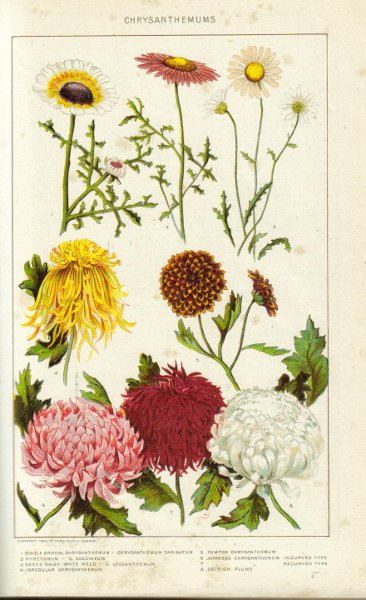Chrysanthemum
 Common names: Ju Hua, Mums, Hardy mums, Garden mums. The word in the west comes from the Greek krysous (gold) and anthemon (flower)
Common names: Ju Hua, Mums, Hardy mums, Garden mums. The word in the west comes from the Greek krysous (gold) and anthemon (flower)
Scientific name: Chrysanthemum morifolium
Climate: Tempered
Plant description: Shrubby or semi-shrubby herbaceous plant, it can be perennial or annual, depending on the species, it has a woody base, it measures between 20 and 150 cm in height. The leaves are simple greyish-green in color with a lobed limbus. The flowers are large heads clustered at the tips of the stems. The colors of the chrysanthemum are very varied: white, cream, yellow, various shades of pink and lilac. The flower is at its peak between late summer and early fall. The chrysanthemum is native to China, from there it was introduced to Japan and from there to the world.
Cultivation: Chrysanthemum is one of the oldest flowers cultivated by humanity, from 1500 B.C. it was cultivated in ancient China. They can be multiplied by seed, cuttings or division of the bushes in late spring. You can also divide the shoots from the base of the bush. They are not difficult to grow but they need full sun, they are susceptible to cold blooming and must be protected from strong winds. They prefer a well-drained soil enriched with organic matter. To conserve moisture, the soil must be mulched with old organic fertilizer, straw, garden compost or peat. Irrigate water, without wetting the foliage. Chrysanthemums eat a lot, but they should not be fertilized more than three times a year or they will grow a lot and with a very heavy head.
Uses: It is used as an ornament in many parts of the world and has a strong cultural load in many countries. In China, the flower is infused and eaten in stews. The leaves are cooked and eaten as a vegetable.
Insecticide. The seed shells contain an active ingredient called pyrethrin, which attacks the nervous system of all insects and inhibits female mosquitoes from biting. Even when it is not present in fatal concentrations for insects it serves as a repellent. They are biodegradable and decompose in sunlight. They are considered the safest insecticides in environments close to food.
Plagues and diseases: Chrysanthemum fly (Liriomyza trifolii), red spider and soil nematodes. They can also suffer root and stem rot, brotitis, rust, powdery mildew and some viruses.
References:
colaboradores de Wikipedia. (2020, June 26). Chrysanthemum. Wikipedia, La Enciclopedia Libre. https://es.wikipedia.org/wiki/Chrysanthemum
EcuRed. (n.d.). Chrysanthemum - EcuRed. Retrieved July 15, 2020, from https://www.ecured.cu/Chrysanthemum
Infojardin, T. (n.d.). Crisantemo - Chrysanthemum morifolium = Dendranthema morifolium. InfoJardin. Retrieved July 15, 2020, from https://fichas.infojardin.com/perennes-anuales/chrysanthemum-morifolium-crisantemo.htm
M, S. (2017, May 16). Chrysanthemum morifolium o Crisantemo. Blog de Jardinería, Plantas y Flores. https://jardineriaplantasyflores.com/fichas/chrysanthemum-morifolium-o-crisantemo/
The Royal Horticultural Society. (n.d.). How to grow chrysanthemums / RHS Gardening. Royal Horticultural Society. Retrieved July 15, 2020, from https://www.rhs.org.uk/plants/popular/chrysanthemum/growing-guide
Wikipedia contributors. (2020, July 13). Chrysanthemum. Wikipedia. https://en.wikipedia.org/wiki/Chrysanthemum
En español: Crisantemo
